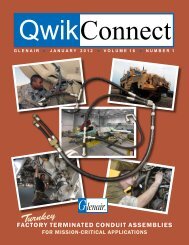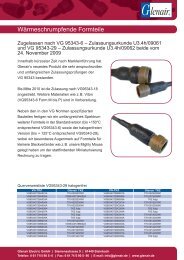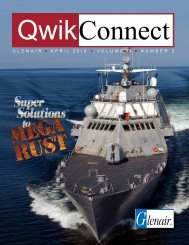RoHS - Glenair UK Ltd
RoHS - Glenair UK Ltd
RoHS - Glenair UK Ltd
You also want an ePaper? Increase the reach of your titles
YUMPU automatically turns print PDFs into web optimized ePapers that Google loves.
common finish of this type provided by <strong>Glenair</strong>.<br />
Other choices include cromate over cadmium,<br />
zinc-cobalt, and zinc-nickel.<br />
Component parts must be individually wired in order to form<br />
the electrical circuit required in the electroplating process.<br />
When current is passed through the electrolyte rich plating<br />
solution, the parts become the cathode and the sacrificial<br />
plating material becomes the anode in the galvanic process.<br />
Passivation<br />
Stainless steel parts require a special finish<br />
treatment known as “passivation.” The chromium<br />
content of stainless steel causes the natural<br />
formation of an invisible, corrosion-resisting<br />
chromium oxide film on the steel surface. If<br />
damaged mechanically or chemically, this film is<br />
self healing as long as oxygen is present. The<br />
protective quality of this oxide film layer can be<br />
enhanced by passivation.<br />
4<br />
QwikConnect<br />
According to ASTM A380, passivation is "the<br />
removal of exogenous iron or iron compounds<br />
from the surface of stainless steel by means<br />
of a chemical dissolution, most typically by<br />
a treatment with an acid solution that will<br />
remove the surface contamination, but will not<br />
significantly affect the stainless steel itself." The<br />
ASTM spec goes on to describe passivation as<br />
"the chemical treatment of stainless steel with<br />
a mild oxidant, such as a nitric acid solution,<br />
for the purpose of enhancing the spontaneous<br />
formation of the protective passive film."<br />
Passivation removes "free iron" contamination<br />
left behind on the surface of the stainless steel<br />
from casting, machining and other secondary<br />
operations. These contaminants are potential<br />
corrosion sites if not removed.<br />
Passivation, combined with a high quality grade of stainless<br />
steel, can create products which are extremely corrosionresistant<br />
and will provide many years of service.<br />
Anodization<br />
Anodizing is an electrolytic process that<br />
places aluminum oxide films on aluminum.<br />
The resulting coating is uniform, much harder,<br />
and denser than natural oxidation. It is formed<br />
by converting the surface of the part with a<br />
simultaneous penetration and build-up of<br />
aluminum oxide. Unlike paint, which can flake<br />
off if not applied properly, anodized finishes<br />
are actually formed from the base material and<br />
cannot flake off. The aluminum oxide finish is<br />
QwikConnect n January 2009











